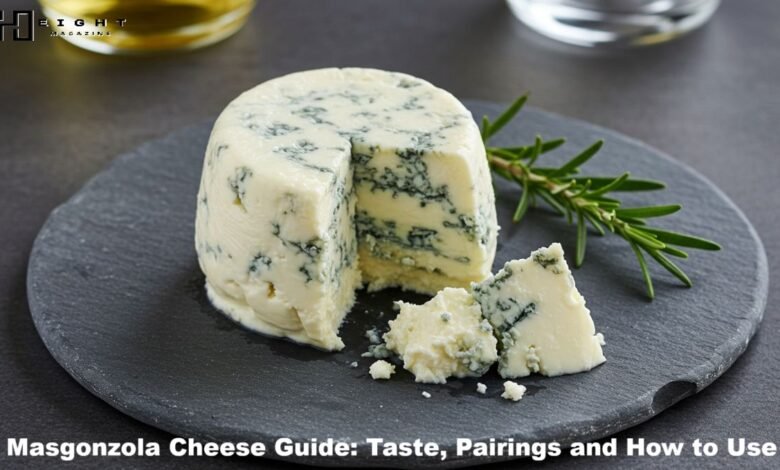Masgonzola Cheese Guide: Taste, Pairings and How to Use

What Is Masgonzola?
Masgonzola is a layered Italian cheese that combines mascarpone with Gorgonzola Dolce. It has a creamy texture, a mild blue‑vein tang, and a beautiful marbled look. This combination makes blue cheese smoother and easier to enjoy, even for beginners.
The Story Behind Masgonzola
Masgonzola is the result of Italian cheesemakers experimenting with balance.
By layering rich mascarpone and Gorgonzola Dolce, they created a way to enjoy blue cheese without overwhelming flavors.
It represents harmony: tradition and innovation blended into one wheel.
Gorgonzola: A Blue Classic
Where It Comes From
Gorgonzola has been made for centuries in northern Italy, particularly in Lombardy and Piedmont.
It is a cow’s milk blue cheese with natural mold veining.
Protected by European PDO rules, its quality and origin are carefully controlled.
Two Types of Gorgonzola
- Dolce: soft, mild, buttery, and spreadable
- Piccante: firmer, crumbly, sharper, and more intense
For masgonzola, the dolce style is always chosen.
Mascarpone: Cream and Sweetness
Mascarpone is a fresh cream cheese that is rich, smooth, and mildly sweet.
Famous for its role in tiramisu, it adds a soft touch to savory and sweet recipes.
Blending it with blue cheese tones down sharp flavors and brings a gentle, creamy sweetness to the taste.
How Masgonzola Is Made
Artisans prepare masgonzola by carefully layering Gorgonzola Dolce with mascarpone.
This process creates an elegant marbling of blue veins and cream-colored cheese.
The layered block is aged for a shorter time than traditional Gorgonzola, so the flavors stay soft and balanced.
Flavor, Texture, and Appearance
Taste
Masgonzola begins with a creamy, buttery taste from mascarpone.
As you chew, the gentle tang and mild mold of Gorgonzola come forward.
The flavor is soft and round, with none of the bitterness found in sharper blue cheeses.
Texture
This cheese is soft, spreadable, and slightly firm in the layers.
It melts easily when warmed, making it versatile in cooking.
Appearance
The marbled pattern of white and pale blue makes masgonzola stand out visually on any cheese plate.
How to Enjoy Masgonzola
On a Cheese Board
Serve masgonzola with:
- Thin slices of crusty bread or artisan crackers
- Honey, fig jam, or fresh grapes
- Toasted walnuts or almonds for a crunchy contrast
This pairing balances sweetness, creaminess, and light saltiness.
In Everyday Cooking
- Melt it into a risotto at the last minute for a velvety finish
- Add to creamy pasta sauces for depth of flavor
- Use as a topping for baked potatoes or roasted vegetables
-
Layer it inside a fresh sandwich along with slices of prosciutto and a handful of peppery greens.
As a Gourmet Ingredient
- Blend into polenta or grits
- It also works beautifully as a smooth filling inside baked tarts or thin savory crepes.
- Stir into soups for extra richness
Wine and Drink Pairings
Masgonzola pairs beautifully with:
- Sweet wines like Sauternes or Moscato
- Full-bodied reds such as Barbera, Zinfandel, or Syrah
- Port-style dessert wines for a luxurious pairing
- Dark beers like stouts or porters
The mild blue notes balance these drinks’ bold or sweet flavors.
Nutritional Highlights
Masgonzola is rich in protein and calcium, with high fat content.
It typically has low carbohydrates, making it suitable in moderation for low-carb or keto eating.
As with all cheeses, portion control is recommended.
Storing Masgonzola Safely
- Wrap it in parchment or wax paper, then cover loosely with foil
- Store in the refrigerator in the cheese drawer
- Bring to room temperature before serving for best flavor
- Avoid freezing, it changes the smooth texture
Tips for Buying Masgonzola
Look for labels that say:
- “Gorgonzola e Mascarpone”
- “Mascarpone-Gorgonzola Blend”
- Or specialty names such as “Mughetto” from artisan cheesemakers
You can find it in Italian specialty stores, gourmet cheese shops, or online.
Masgonzola vs. Other Blue Cheeses
| Cheese | Texture | Flavor Profile | Intensity |
|---|---|---|---|
| Masgonzola | Soft, layered | Creamy, mild tang | Gentle |
| Gorgonzola Dolce | Soft, creamy | Mild, buttery, lightly tangy | Mild |
| Gorgonzola Piccante | Firm, crumbly | Sharp, salty, pungent | Strong |
| Roquefort or Stilton | Firm, crumbly | Complex, spicy | Bold |
Masgonzola is the softest and most approachable of them all.
Real-World Story
At a casual dinner party, a guest who usually avoided blue cheese decided to try a small piece of masgonzola on a slice of pear with honey.
The combination was sweet, creamy, and mild. They were surprised that blue cheese could be so gentle.
That small taste gave them the confidence to explore new cheeses later.
Where to Find Masgonzola
- Italian cheese shops
- Specialty gourmet markets
- Online retailers specializing in imported cheeses
Look for it in the soft cheese section or ask for a mascarpone-gorgonzola blend.
Why Masgonzola Matters
Masgonzola is a testament to Italian culinary creativity.
It blends two iconic cheeses into a product that welcomes everyone, from cheese lovers to those hesitant about bold flavors.
Its balance of creaminess and mild blue tang shows that tradition and innovation can coexist on the same plate.
Conclusion
Masgonzola is a layered Italian cheese made from mascarpone and Gorgonzola Dolce.
It offers a gentle introduction to blue cheese, combining creamy sweetness with soft tang.
Handled and served properly, it’s a versatile cheese that works equally well on a board, in pasta, or in gourmet cooking.
FAQs About Masgonzola
Is masgonzola vegetarian?
Not always. Many traditional Gorgonzolas use animal rennet. Read the packaging carefully if vegetarian preparation is important to your diet.
Does masgonzola contain mold?
Yes. It includes the blue mold from Gorgonzola. People with mold allergies or sensitivities should avoid it.
Is it keto-friendly?
Yes. Masgonzola is low in carbohydrates and rich in fats and proteins, making it a good fit in moderation.
Can you freeze it?
Freezing changes its texture. Keep it chilled in the fridge and try to enjoy it while it is still fresh for the best texture and flavor.
What to Try Next
- Taste it with honey and nuts on a cheese board
- Stir it into hot risotto or pasta
- Offer it as a soft, approachable blue cheese at your next gathering
Masgonzola is proof that even bold traditions can be made gentle. Be curious, taste carefully, and let each bite open the door to discovery.




